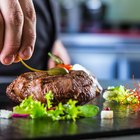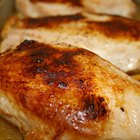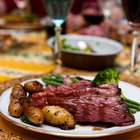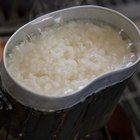Using a cooking or meat thermometer measures the internal temperature of meats and egg dishes. It's not only necessary to check the temperature in order to destroy harmful bacteria in your food, but it ensures your food is cooked to precision every time. The U.S. Department of Agriculture reports that temperature is the only accurate way to calculate whether food is fully cooked. Using a probe cooking thermometer is perfect because it gives a to-the-second readout of the internal food temperature and an audio/visual alert when the set temperature is reached.
Insert the probe into the center of the food item, about halfway in for food dishes prepared in the oven or barbeque.
Put the dish in the oven or barbeque and shut the door/lid, covering directly over the unit’s sensor cable.
Set the temperature alert according to USDA recommended cooking temperatures for safety.
Wait for the audio/visual alert to tell you when your food is done.
Related Articles

What Is the Difference Betweeen Cooking ...

How to Convert Stovetop Recipes to ...

How to Cook Steak on FlavorWave

How to Make Pollo Asado-Marinated ...

Can You Bake Sliders?

Can You Cook Something Frozen in the ...

Toaster Oven Cooking Times

How to Make Teriyaki Sauce

How to Calculate Portions

How to Cook a Roast Beef on a ...

How to Change a Fossil Watch Battery

How Do I Change the Time on a Timex ...

How to Assemble a Food Mill

How to Reheat Chinese Takeaway

How to Stop AARP Mail

How to Heat Pre-Cooked Hams

How to Cook Salmon Fillets on the Stove ...

How to Cook Rice in a Thermos

Cooking Instructions for a Ridge Creek ...

How to Bake Boneless Skinless Tilapia
References
Tips
- Prior to use, clean the thermometer probe. Meat should stand for 10 to 15 minutes after removing it from the oven or grill, stabilizing the internal temperature of the meat and properly redistributing the juices.
Warnings
- When cooking, always wear a heat resistant glove. Keep the unit away from children. Clean and dry the probe thoroughly after each use. Never tamper with the unit's internal components. Keep the unit out of excessive direct sunlight.